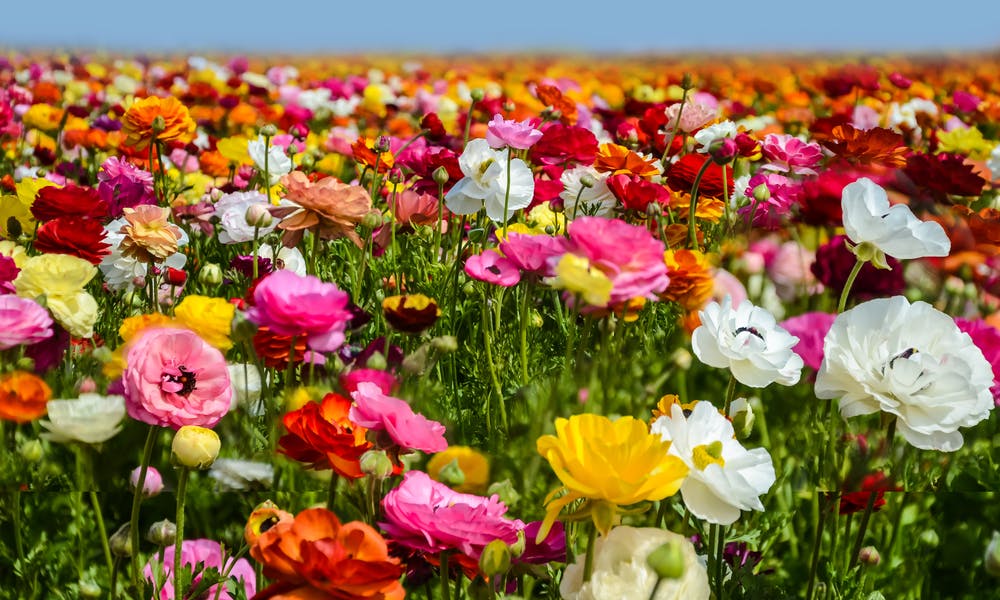Human well-being can be broken down into three parts: physical, psychological, and relational. Flowers are perfect for contributing to these three aspects. In fact, they can help in the physical and psychological ones by reducing stress-levels and enhancing feelings of happiness and inner peace. They also affect the relational aspect because offering flowers is a sign of care, love, and respect.
The flower you are going to learn about now is called the ranunculus flower. It is one of the most sublime and used flowers around the world in gardening and compositions. It can add a beautiful look to any garden with its brightly colored flowers and illuminate any long-lasting bouquet.
The ranunculus flower is full of wonders. From its characteristics, meanings, flowering, and gardening tips, this flower is not going to be a secret anymore. For that, let us follow these points:
* Graceful Characteristics of the Ranunculus Flower
* Some Points about the History and the Meaning of the Ranunculus Flower
* Is the Ranunculus Flower Perfect in Bouquet?
* How to Plant Your Own Ranunculus Flower?
* How to Maintain It?
Graceful Characteristics of the Ranunculus Flower
The ranunculus, also known as the garden buttercup, is one of the most common and widespread species. It is a perennial herbaceous plant belonging to the large family of Ranunculaceae. The main characteristics of this flower are its resistance to temperatures of -10 degrees C, the beauty of its flowers, and its good vase holding capacity.
This graceful flower is native to three parts of the world: south-west Asia, northern Africa, and the eastern Mediterranean. It stands fiercely up to 45 cm high. It has many slightly curved roots, similar to those of the lily of the valley.
With its fleshy and delicate flowers, the ranunculus flower inspires feelings of tenderness and comfort. You can find it in a large variation of flowers, such as white, green, pink, red, yellow, and a whole world of other shades. This perennial herbaceous blooms from winter to spring.
Some Points about the History and the Meaning of the Ranunculus Flower
The first crusaders of Saint-Louis (Louis IX) discovered the graceful ranunculus in the 13th century in the Holy Land. However, at that time in Europe, the flower went almost unnoticed. It was only famous in the gardens of the Ottoman rulers. In the 17th century, Sultan Mohammed IV successfully introduced the flower to Europe a second time. It took some time before it arrived in America’s lands.
The ranunculus flower has a special meaning in the language of flowers. It is considered the flower of seduction. Moreover, it praises the beauty of its receiver! You can see it as offering a compliment or a way to proclaim clearly: “you are charming.” A bouquet of red ranunculus is a way to express a mad attraction, while a bouquet of pink ranunculus represents a timid attraction.
Is the Ranunculus Flower Perfect in Bouquet?
The answer to your question is “Y-E-S”. This flower is perfect to offer! Especially for any romantic occasion, because, as we have seen above, it is one of the flowers of seduction. Moreover, the ranunculus has the particularity of holding up very well as a bouquet.
Here are a few pieces of advice for you to make your bouquet of ranunculus last in a vase. First, cut the stem at an angle, put them in a vase, and we guarantee you a positive result!
Then, watch the water carefully depending on the room temperature. Regularly cut the base at an angle to allow water to penetrate the stem. Finally, change the water every 2-3 days. Voila!
How to Plant Your Own Ranunculus Flower?
The beautiful ranunculus flower appreciates full sun and light; however it prefers half-shade in hot regions. It needs a non-calcareous, rich, and well-drained soil because it fears stagnant moisture that causes the roots to rot, as it is the case for many other plants.
In areas with mild winters, you can easily plant your ranunculus flowers in autumn. This way, you are going to have an early flowering in April to have your own “colorful spring.” However, in colder areas, you must wait until the coming of spring to plant them and ensure early summer flowering.
Here is how to plant it: Put the downward-pointing roots 5 cm deep from the soil surface with 15 to 20 cm spacing, depending on the desired effect. During their growth, ranunculus needs regular watering, especially in regions with dry weather.
How to Maintain It?
Your ranunculus flower needs your care to grow and be the healthy plant you like. During the growing process, water it regularly, especially if you are in a hot and dry weather. Allow the substrate to dry out between waterings.
If you want to boost your plant, add a special fertilizer every two weeks during the flowering period.
Cut off withered flowers after flowering to induce the formation of new blooms. Do not cut the foliage because it can build up reserves that should be accumulated in the roots.
In cold regions, dig up the roots in the autumn, before the first frost, and store them throughout the winter in well-protected, cold, and darkroom. In other areas where the climate is gentler and in well-drained soil, you can leave your plants on the ground.
If you are looking for a meaningful and resistant flower to add to your bouquet or to brighten your garden, we present you the ranunculus. This perennial herbaceous is very famous, especially with its incredible characteristics: its resistance to temperatures of -10 degrees C, the beauty of its flowers, and its good vase holding capacity. In the language of flowers, it is one of the flowers of seduction. If you are looking for a subtle way to express your attraction to someone, just offer him a bouquet of ranunculus. It is a way to give a compliment and proclaim: “you are charming.”
